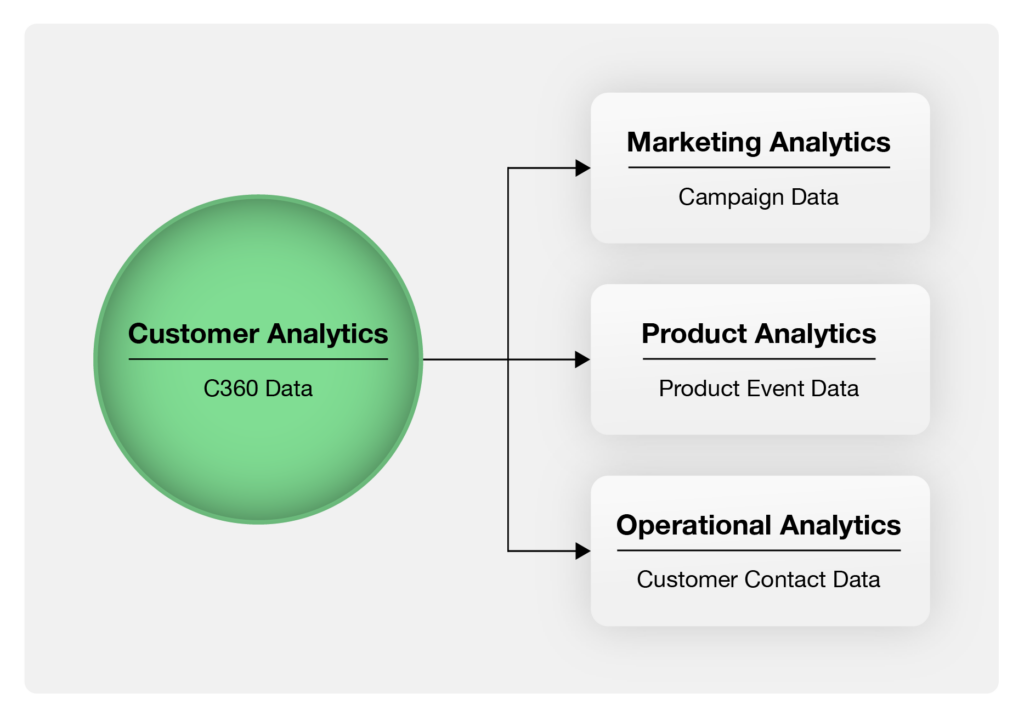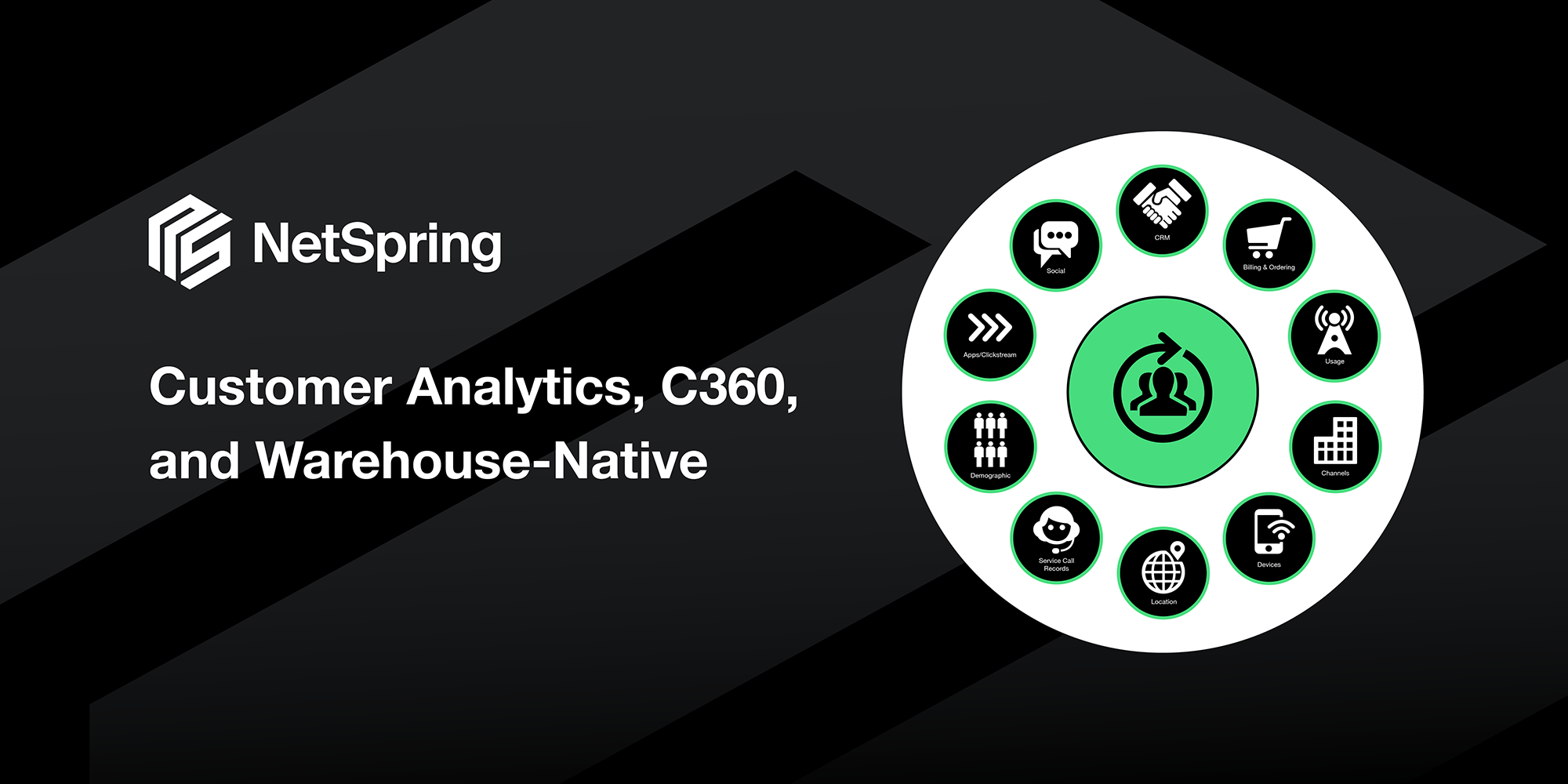Many organizations I’ve worked with in recent years are somewhere in the process of building a Customer 360 (C360) in their data warehouse. The C360 is intended to be a single source of truth, containing all of the data about our customers, that can be used enterprise-wide for everything from reporting to customer activation. Product, Marketing, and Customer Service data… you name it, and the C360 will have it all. And it’s not hard to imagine why one might want this. In a world where businesses are intertwined – what you build determines how you market, and vice versa – and relationships are routinely omnichannel, having such a view is essential.

Figure 1: Branches of Business Analytics and Associated Data
Figure 1 depicts several branches of business analytics being applied today, along with the associated data required. Let’s define each term:
Customer Analytics – Understanding our customers’ past behavior in service of predicting and modifying future behavior through all available data about them
- C360 Data – A unified store of everything we know about the customer and the ideal place from which to perform customer analytics
Marketing Analytics – Measuring and evaluating our customer acquisition efforts to inform future marketing investments and initiatives
- Marketing/Campaign Data – Data about past marketing campaigns and any resulting outcomes involving our customers, often sourced from advertising platforms and our own systems
Product Analytics – Measuring and evaluating the products we deliver to our customers to inform decisions about future product and feature development
- Product Event Data – Data emitted by the product capturing each step in a customer’s interaction with our product
Operational Analytics – Measuring and evaluating the human interactions (e.g. Sales, Customer Care) that we have with our customers to gain insights about the quality of those interactions and where there may be anomalies and opportunities to mitigate them through our product
- Customer Contact Data – Data often generated by our telephony and chat platforms capturing the detailed interactions between our customers and agents
For the purposes of a later discussion, let’s also define the following:
Customer Data Platform (CDP) – An operational data store containing data about our customers, often used for the activation of customers through marketing campaigns and other personalized experiences (e.g. product personalization)
Every enterprise’s desire is to understand the entire customer journey, across every single digital and non-digital touchpoint and over time. They want to understand usage, engagement, conversions, retention and business impacts, but must navigate business systems, data sources, data access, even data types, from time series data to static data. The need for Customer Analytics remains the ultimate goal.
At the center of all this is the C360. The idea of a C360 may seem like a novel concept, but the truth is for most of the history of analytics we had this. We just didn’t have a name for it because this was a base expectation of our data warehouses. So what changed? When products started becoming digital, they produced data at a rate our existing platforms couldn’t handle. This led to fragmentation in our data stack and point solutions, such as product analytics platforms, that hoarded part of what we knew about our customers in their respective silos. In fairness, this concession was a technological necessity as data warehouses were not performant enough to handle these data let alone interweave them with everything else we knew about our customers. But this concession, and others like it in areas such as Marketing, fragmented our view of the customer and left us yearning for a single source of truth.
This isn’t simply a problem in the abstract that leads to fun esoteric debates of little consequence. On the contrary, in one business where I led analytics, one of our biggest challenges with our product analytics solution was keeping our PMs from reporting the retention numbers provided by the platform. Because the product data lived in one silo and our offline (phone) cancellation data lived in another, the retention rates reported in our products analytics solution was materially overstated. Instead, for retention reporting we had to pipe product event data into the warehouse and manually build retention reports – greatly slowing down the whole business and materially defeating the purpose of investments in product analytics.
Eventually database platforms like Snowflake and Databricks caught up to the problem. Now our warehouses can process high volumes of things like product event data with low enough latency to satisfy most use cases. The silos in Marketing and Product cease to be technological necessities and instead are just artifacts of our existing data stacks. At last, we can bring it all together and build solutions in our data warehouses – CDPs, product analytics, C360s, etc. can all be done in the same place. What makes the idea of warehouse-native so compelling is that because all of these things are in the same place, we can prevent duplication and the associated increases in things like storage costs and data inconsistencies.
In fact, looking at many of these C360s, they look oddly like CDPs. Not only do they have many of the same data elements, many of the use cases are complementary to each other. The customer attribute sitting in our CDP used to target a campaign is the same thing we need in our reporting solution to dimensionalize campaign and business performance. In many cases, these attributes are derived from the product event data that previously had to be siloed in the product analytics solution. The conceptual re-use of data elements across use cases makes total sense. After all, the customer attribute is interesting because it is actionable, so the question becomes how do we make the physical implementation one and the same? The advent of performant data warehouse platforms and then warehouse-native analytics has brought us to a point where the C360 and the CDP can be one and the same.
This brings us back to where we started – Customer Analytics and activation happen in the same place and at the same cadence. No more functional silos to fracture our view of the customer and keep us from understanding them to the degree necessary to serve them well. The modern data stack, including warehouse-native platforms, reunites us with our customers, and not a moment too soon.
To learn more about NetSpring’s warehouse-native Customer Analytics solution for marketing, product, or operational analytics, visit the website and request a demo today!
John Humphrey has over two decades of experience helping companies unlock insights and activate data at scale. His experience includes having been the first data hire at Goodreads (acquired by Amazon), leading LegalZoom’s data org through its IPO, and most recently serving as Chief Data Officer at Intuit Mailchimp. John is an advisor at NetSpring.












